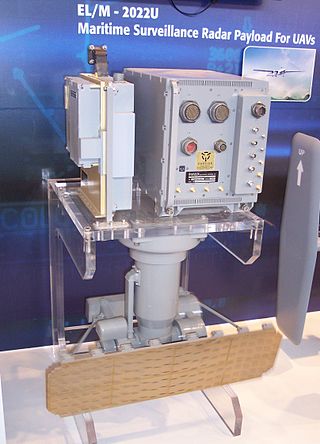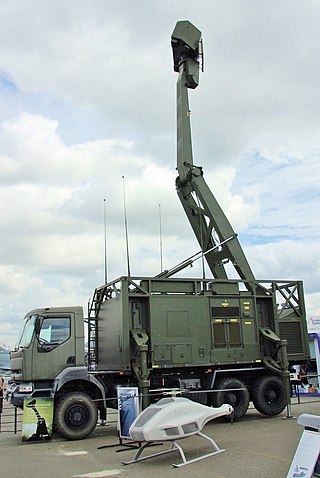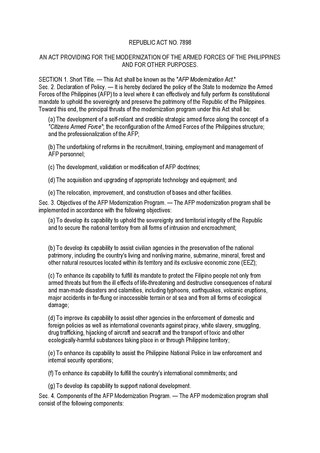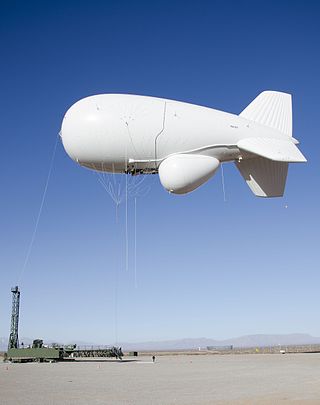Operators
 Israel
Israel  India
India  Philippines
Philippines - Philippine Navy [2] [3]
 Singapore
Singapore
| EL/M-2083 | |
|---|---|
| Overview | |
| Primary function | Air search radar |
| Mass | kg |
| Height | m |
| Width | m |
| Depth | m |
| Time of service entry | 2005 |
| Maximum range | 500 km |
| Maximum detection altitude | ft |
The EL/M-2083 is an aerostat-mounted Airborne early warning and control radar. Another system of this kind is the Tethered Aerostat Radar System.
It is an early warning and control active electronically scanned array radar designed to detect hostile approaching aircraft from long ranges, especially when they approach at low altitudes. Data gathered by the radar is transmitted to a central air defense command & control center where it is used to maintain an extended comprehensive air situation picture.
Once a potential threat has been detected the onboard system alerts responders in a timely manner.
Detection range for fighter aircraft is in excess of 250 km (135 Nm). [1]
It is based on the EL/M-2080 Green Pine.

The Northrop Grumman E-2 Hawkeye is an American all-weather, carrier-capable tactical airborne early warning (AEW) aircraft. This twin-turboprop aircraft was designed and developed during the late 1950s and early 1960s by the Grumman Aircraft Company for the United States Navy as a replacement for the earlier, piston-engined E-1 Tracer, which was rapidly becoming obsolete. The aircraft's performance has been upgraded with the E-2B and E-2C versions, where most of the changes were made to the radar and radio communications due to advances in electronic integrated circuits and other electronics. The fourth major version of the Hawkeye is the E-2D, which first flew in 2007. The E-2 was the first aircraft designed specifically for AEW, as opposed to a modification of an existing airframe, such as the Boeing E-3 Sentry. Variants of the Hawkeye have been in continuous production since 1960, giving it the longest production run of any carrier-based aircraft.

An airborne early warning and control (AEW&C) system is an airborne radar early warning system designed to detect aircraft, ships, vehicles, missiles and other incoming projectiles at long ranges, as well as performing command and control of the battlespace in aerial engagements by informing and directing friendly fighter and attack aircraft. AEW&C units are also used to carry out aerial surveillance over ground and maritime targets, and frequently perform battle management command and control (BMC2). When used at altitude, the radar system on AEW&C aircraft allows the operators to detect, track and prioritize targets and identify friendly aircraft from hostile ones in real-time and from much farther away than ground-based radars. Like ground-based radars, AEW&C systems can be detected and targeted by opposing forces, but due to aircraft mobility and extended sensor range, they are much less vulnerable to counter-attacks than ground systems.

The RCA 474L Ballistic Missile Early Warning System was a United States Air Force Cold War early warning radar, computer, and communications system, for ballistic missile detection. The network of twelve radars, which was constructed beginning in 1958 and became operational in 1961, was built to detect a mass ballistic missile attack launched on northern approaches [for] 15 to 25 minutes' warning time also provided Project Space Track satellite data.

An active electronically scanned array (AESA) is a type of phased array antenna, which is a computer-controlled antenna array in which the beam of radio waves can be electronically steered to point in different directions without moving the antenna. In the AESA, each antenna element is connected to a small solid-state transmit/receive module (TRM) under the control of a computer, which performs the functions of a transmitter and/or receiver for the antenna. This contrasts with a passive electronically scanned array (PESA), in which all the antenna elements are connected to a single transmitter and/or receiver through phase shifters under the control of the computer. AESA's main use is in radar, and these are known as active phased array radar (APAR).

A radar picket is a radar-equipped station, ship, submarine, aircraft, or vehicle used to increase the radar detection range around a nation or military force to protect it from surprise attack, typically air attack, or from criminal activities such as smuggling. By definition a radar picket must be some distance removed from the anticipated targets to be capable of providing early warning. Often several detached radar units would be placed in a ring to encircle a target to provide increased cover in all directions; another approach is to position units to form a barrier line.

The EL/M-2075 Phalcon is an airborne early warning and control (AEW&C) active electronically scanned array radar system developed by Israel Aerospace Industries (IAI) and Elta Electronics Industries of Israel. Its primary objective is to provide intelligence to maintain air superiority and conduct surveillance. It was surpassed by newer versions—the EL/W-2085 and the EL/W-2090.

An early-warning radar is any radar system used primarily for the long-range detection of its targets, i.e., allowing defences to be alerted as early as possible before the intruder reaches its target, giving the air defences the maximum time in which to operate. This contrasts with systems used primarily for tracking or gun laying, which tend to offer shorter ranges but offer much higher accuracy.

ELTA Systems Ltd (ELTA) is a leading Israeli defense technology company specializing in designing, developing, and producing advanced electronic systems and sensors. A group and subsidiary of the government-owned Israel Aerospace Industries (IAI) offers an extensive product portfolio encompassing Radar, ELINT, COMINT, C4STAR, Electronic Warfare, Communications, Autonomous Ground vehicles and Cyber systems. The company's products are utilized by Defense forces, Homeland Security, and law enforcement organizations utilize the company's products worldwide.

The Saab Giraffe Radar is a family of land and naval two- or three-dimensional G/H-band passive electronically scanned array radar-based surveillance and air defense command and control systems. It is tailored for operations with medium- and Short Range Air Defense (SHORAD) missile or gun systems, or for use as gap-fillers in a larger air defense system.

The Tethered Aerostat Radar System (TARS) is an American low-level airborne ground surveillance system that uses aerostats as radar platforms. Similar systems include the EL/M-2083 and JLENS.
The Elta 2052 or EL/M-2052 is an X-Band airborne Active Electronically Scanned Array (AESA) fire control radar (FCR) designed for fighter aircraft to support air-to-air combat and strike missions. Currently, it is fitted in the SEPECAT Jaguar as part of the Indian Air Force (IAF) DARIN III upgrade program. The radar is also fitted in HAL Tejas, and could also be used on other fighter aircraft such as F-15, MiG-29, Mirage 2000, and FA-50 Block 20.

Airborne ground surveillance (AGS) refers to a class of military airborne radar system used for detecting and tracking ground targets, such as vehicles and slow moving helicopters, as opposed to Airborne early warning and control, whose primary role is detecting and tracking aircraft in flight. Antenna beam width should be very small to enhance resolution. This antenna size limitation demands high frequency of operation, to be operated in this mode. AGS radar is typically a medium or low power radar. It includes both maritime and land surveillance. Today, UAVs perform this operation, which often uses optical aids for surveillance.

The EL/M-2080 Green Pine is an Israeli ground-based missile defense radar produced by Elta Systems, a subsidiary of Israel Aerospace Industries, to operate mainly with the Arrow theater missile defense system of Israel, which is jointly funded and produced with the United States. The system was exported to India, and its advanced version, the Green Pine Block-B, was delivered to South Korea at a cost of $83 million per unit, and to Azerbaijan. The Israeli Air Defense Command within the Israeli Air Force (IAF) of the Israel Defense Forces (IDF) operates both Green Pine radars and Green Pine Block-B radars as an integral part of the Arrow system.

The EL/W-2085 is an airborne early warning and control (AEW&C) multi-band radar system developed by Israel Aerospace Industries (IAI) and Elta Electronics Industries of Israel. Its primary objective is to provide intelligence to maintain air superiority and conduct surveillance. The system is currently in-service with Israel, Italy, and Singapore.

The Philippine Air Force (PAF) is the aerial warfare service branch of the Armed Forces of the Philippines. Initially formed as part of the Philippine Army as the Philippine Army Air Corps (PAAC) in 1935, the PAAC eventually saw combat during World War 2 and was formally separated from the Army in 1947 as a separate service branch of the AFP under Executive Order No. 94. At present, the PAF is responsible for both defending Philippine airspace, and conducting aerial operations throughout the Philippines, such as close air support operations, combat air patrols, aerial reconnaissance missions, airlift operations, helicopter tactical operations, special operations, and aerial humanitarian operations, which includes search and rescue operations. The PAF has also carried out various missions within the country and abroad.

The IAI EL/W-2090 is an airborne early warning and control (AEW&C) radar system developed by Israel Aerospace Industries (IAI) and Elta Electronics Industries of Israel. Its primary objective is to provide intelligence to maintain air superiority and conduct surveillance. The system is currently in-service with the Indian Air Force.

The Armed Forces of the Philippines (AFP) Modernization Act, officially designated as Republic Act No. 7898, was a Philippine law that was enacted on February 23, 1995, by President Fidel V. Ramos. It was aimed to modernize all branches of the Armed Forces of the Philippines (AFP) such as the Philippine Air Force, Philippine Navy, and the Philippine Army. The law was amended by Republic Act No. 10349, also known as the Revised AFP Modernization Act, on December 11, 2012.

The Joint Land Attack Cruise Missile Defense Elevated Netted Sensor System, or JLENS, was a tethered aerial detection system designed to track boats, ground vehicles, cruise missiles, manned and unmanned aircraft, and other threats. The system had four primary components: two tethered aerostats which utilized a helium/air mix, armored mooring stations, sophisticated radars, and a processing station designed to communicate with anti-missile and other ground and airborne systems. Each system was referred to as an "orbit", and two orbits were built. The Army-led joint program which fielded JLENS was designed to complement fixed-wing surveillance aircraft, saving money on crew, fuel, maintenance and other costs, and give military commanders advance warning to make decisions and provide notifications. Following cost overruns, underperformance, declining support in Congress, and public scrutiny following a snapped tether which allowed one craft moored at Aberdeen Proving Ground, Maryland to drift on a 100-mile uncontrolled descent across Pennsylvania, dragging its cable tether which damaged power lines and cut power to 20,000 homes, the program was suspended in October 2015, and completely discontinued by 2017.

The ELM-2084 is an Israeli ground-based mobile 3D AESA multi-mission radar (MMR) family produced by ELTA, a subsidiary of Israel Aerospace Industries.

The AN/TPY-2 Surveillance Transportable Radar, also called the Forward Based X-Band Transportable (FBX-T) is a long-range, very high-altitude active digital antenna array X band surveillance radar designed to add a tier to existing missile and air defence systems. It has a range of 2,900 mi. Made by Raytheon, it is the primary radar for the Terminal High Altitude Area Defense (THAAD) missile system, but also cues the AN/MPQ-53 radar of the MIM-104 Patriot system. Patriot PAC-3 is a lower-altitude missile and air defense system than THAAD.
{{cite web}}: CS1 maint: archived copy as title (link)